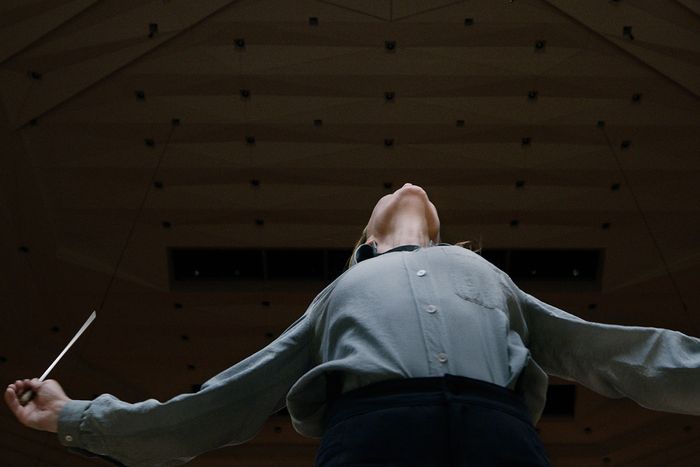
The movie Tár opens with an unlikely dramatic gambit: the recitation of a résumé. Lydia Tár, played with bristling confidence by Cate Blanchett, is being introduced at a public conversation. She has served as music director of the Boston Symphony Orchestra, the New York Philharmonic, and several other world-class ensembles before taking over the Berlin Philharmonic. The days of the celebrity conductor — the ubiquitous, paparazzi-drawing, Time-worthy maestro — died with Leonard Bernstein, but they have returned for her. And so we know from the opening credits that classical music will provide the movie with more than just trappings: It’s the source of the title character’s energy, the currency of her prestige, and the means of her betrayal. Her gender is no big deal, Tár tells The New Yorker’s Adam Gopnik onstage: Pioneers like Marin Alsop threw open the gates so the next generation (hers, even though she’s barely a decade younger) can be judged by music-making alone. That statement lands like a character in a horror movie eyeing a darkened mansion and murmuring, “It looks empty.” The audience knows better.
Tár — née Linda Tarnopolsky, Tarnowicz, Tarantino, or whatever unspecified multisyllabic surname she jettisoned after growing up in a working-class section of Queens — wants so badly to outcompete her male peers that she adopts their sense of invulnerability and emulates their sins. That doesn’t exactly make this a feminist epic. With obsessive attention to the arcana of classical music, the writer-director Todd Field creates a paragon of female triumph in the ultimate patriarchal profession. Then he destroys her.
Women have wielded onscreen power as executives (Joy), drug lords (La Reina del Sur), fashion editors (The Devil Wears Prada), lawyers (The Good Fight), military officers (Eye in the Sky), presidents (Homeland), and, of course, queens (The Queen). But a woman who occupies a series of the most rarefied podiums borders on science fiction. In the real world, only a handful of men (mostly in their 70s now) have had her kind of career. For women, a top job at even one of the top orchestras remains a chimera. Alsop has been blazing trails for 40 years, but a woman has yet to hold the conducting post at one of the old A-list orchestras in Europe (Berlin, Amsterdam, London) or America’s top five (in New York, Boston, Cleveland, Philadelphia, and Chicago). Female conductors with great talent and long experience still have to hack through a forest of firsts. The 53-year-old Susanna Mälkki, for instance, remains the first and only woman to run the Ensemble Intercontemporain, lead a single opera at La Scala, be appointed principal guest conductor at the Los Angeles Philharmonic, and take over the Helsinki Philharmonic.
Yet Tár’s real-world colleagues keep flicking away the gender question much as she does. In 2018, La Scala’s music director, Riccardo Chailly, opined that life was no longer especially challenging for women in his profession. “There is sensitivity, sensibility, and flexibility in the female way of music-making that obviously is gaining more and more praise worldwide,” he said, a masterpiece of sexist condescension masquerading as open-mindedness. (Whatever it might mean to make music in “the female way,” Tár certainly doesn’t.)
The film does go to enormous and admirable lengths to get musical details right. On the podium, Blanchett looks crisp, not just like an actor waving her arms. Her timekeeping and gestures are persuasive, her musical comments sharp, her shop talk realistic. Even her mockery is on the money, though a few jokes will be intelligible only to music-world initiates. The quasi-comical character of Elliot Kaplan, an American businessman and Mahler enthusiast who wants desperately to be taken seriously as a conductor, is obviously based on Gil Kaplan, who made a specialty of a single work: Mahler’s Second Symphony. Tár’s wife, a violinist, is the orchestra’s concertmaster, a situation that might seem implausibly sticky but also has a real-life counterpart: The former New York Philharmonic music director Alan Gilbert was leading the Royal Stockholm Philharmonic Orchestra when he married one of its cellists, Kajsa William-Olsson.
Yet precisely because Field weaves such a fastidiously accurate background, the clinkers are loud and seem intentional. We get a glimpse of Tár’s capacity for cruelty in a Juilliard master class for student conductors. That format — a small and worshipful group, a self-aggrandizing legend, and an insecure guinea pig selected for public exposure — is the perfect showcase of sadism and self-revelation. Terrence McNally nailed the genre in his 1995 play Master Class. Here, the teacher eviscerates a student conductor-cellist not for his talent or technique but for his choice of music (by the real-life Icelandic composer Anna Thorvaldsdóttir) and for his casual dismissal of Bach as insufficiently BIPOC or gender fluid to be relevant to him. She has no patience for the identity the student has assembled out of race, gender, and sexuality. Her own building materials are music and talent; without them, she ceases to exist. Field has invented an absurd victim only to feed his egomaniac’s need to crush them. The scene is an actor’s jackpot, and Blanchett milks it for every Oscar-oriented drop of drama, but as a comment on the classical-music world’s power relations, it’s wildly off target. High-caliber musicians can be impatient, demanding, and brusque, but I’ve never seen one deliberately humiliate a student in public. (I also doubt Juilliard is full of cellists who loathe Bach.)
Tár approaches her orchestra with similar hostility. The movie’s narrative frame is the leadup to recording of Mahler’s Fifth Symphony, the symphonic equivalent of the state-championship game in Friday Night Lights (with no opposing team). She treats rehearsals as a forum for the exercise of power. Instead of working with musicians, she works against them, manipulating the organization’s rules, insulting a principal cellist’s pride, and belittling players in front of their peers — behavior that would cause a mutiny. Even the most dislikable, retrograde, and self-absorbed conductors understand that their mission is to cajole great music out of talented colleagues, the ones who actually do all the blowing and bowing. Conductors charm and wheedle more than they browbeat. Trying to coerce beautiful playing out of resentful musicians is like trying to force someone to love you: inefficient, offensive, and usually counterproductive. Even worse is the conductor who would bludgeon the orchestra into surrendering interpretive creativity and instead demand that players match the version of the score running through her head.
And what is that version, exactly? Tár claims to see the score as the ultimate love song, but how would she know? As her wife points out, the only relationship she has that isn’t transactional is with her young daughter. Mahler bared his own impressively extreme emotions in his Fifth Symphony. Its composition was powered by shocks: a hemorrhage that nearly killed him; his first contact with the love of his life, Alma Schindler; his surging need for new techniques; a desire for a vessel vast enough to hold the panorama of the human psyche. How, he wondered in a letter to Schindler, would the concertgoing bourgeoisie respond “to this primeval music, this foaming, roaring, raging sea of sound, to these dancing stars, to these breathtaking, iridescent, and flashing breakers?” The score demands similar expansiveness and generosity from its interpreters. Tár, though, displays little more than crabbed irritability and self-serving cynicism.
The film uses the mysteries of music to arrive at a set of dull discoveries. Great art can cloak ordinary nastiness. Women can pursue and abuse power just as ruthlessly as men. Artistic projections of love are not the same as the real thing. And the classical-music Establishment, like just about every hierarchical structure, harbors abuse because victims stay quiet and onlookers accept it — until, suddenly, they don’t.


